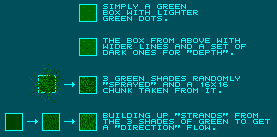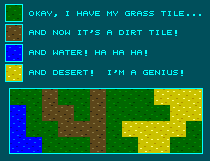|
Part 1: The Almighty Grass Tile
Ah yes, the grass tile...Generally the first tile anyone does,
because hey, if you're making an RPG, and you plan to have it take
place on a world, you're probably going to need grass. It's a good
way to warm up and get into drawing the tiles, so let's start with
it.
Let's cover some different methods of making grass. You've
probably seen these, if you've checked out a lot of games:
 These aren't all the methods, of course, but these are some
popular ones. One that I didn't both to even make a graphic for is
just a green tile, heh...As amusing as that sounds, a lot of people
DO try to get away with this, because grass is green so logically a
green tile will look like grass, right? Heheh...Not so. And this is
the problem both of the top two tiles have. They're basically green
with a few sparse dots on it. They DO represent grass to a player
walking around because if there's nothing else around that's green
and there's trees all over, then in their head they figure it MUST
be grass...But what it really looks like is a smooth plate of green
metal with some dents and bulges in it, or maybe a sheet of green
tinted glass...Maybe a big flat green rock. What these all have in
common is that they are FLAT, and as a result, are generally boring
when it comes to grass. Grass, when you think about it, is millions
of tiny blades randomly growing at different upward angles, and
unless it's been stamped down flat or mowed to perfection, doesn't
look smooth. So why make a tile that does?
So then we come to the more "complex" grass tiles...The ones that
have tons of dots in them. One common method of making these is to
simply take your paint program's "spray" tool and spray down a bunch
of random pixels in the different shades of green, and take a 16x16
chunk out of the middle and use that. Which works, but the problem
with totally random pixel placement is that you sometimes end up
with parts that don't work well (large gaps of one shade of green
for instance), like in the example in the top right corner there's a
large dark green gap...This will harm the look of the tile when we
come to actually using the tile, which I'll explain a bit later.
Another method is to simply paintstakingly draw in the blades,
going from shade to shade. This can get annoying, but the trick is
to not think about it too much, just start doing some random strokes
of up to 4 pixels. A way to cheat is to make a few strokes like
that, then cut and paste those strokes around the tile and cut and
paste a new chunk every few pastes so it still looks somewhat
random, heh. Much faster. This method is the one I personally use
because I like to have more control over what my grass is going to
look like and I find that with the spray method I end up having to
go back and fix it up a bit so it works better on a map, so I just
go with drawing them out from scratch. This is also a good method
for making "thick" grass, like you'd find in a forest where no one
has mowed the grass...The upward strands make it seem taller and
thicker. Incidently if I were to take and rotate the tile 90 degrees
so the lines were going horizontally, it would look as if the grass
had been stamped down by people walking on it. Just something to
keep in mind (small things like changing the angle of the pixels can
alter the whole look of the tile).
Now you can use whatever method you like, and there are a lot of
different ones...Just remember that grass shouldn't look totally
flat, and using the same tile and just changing the shades looks
horrible:
 Do not, I repeat do NOT do this. I guess I should explain why
exactly...other than the fact that it really looks ugly, heh. A big
problem is the repetitive texture. It's the exact same design with
different colors. Now imagine the old days, when an engine scrolled
not by pixel, but by jumping tile to tile (16 pixels with each press
of a direction). Now what would happen is when you're going along,
since the tiles wouldn't scroll, they'd just be replaced instantly
by the next tile in the direction you're going. This demonstrates
the problems with using the same tile with color swaps, as say you
were walking along that chunk of map in the above image...You could
hold down the right direction and all you would see is the color of
the tile change. No difference in the texture at all, and it gets
boring and eventually hard on the eyes to differentiate between the
different land types because you just focus on the pattern which
looks the same. This same effect is noticable if you've ever been
walking on a large area of grass tiles that all look the same...You
could hold down the key for an hour and never know if you're still
walking or if you're bumping against the edge of the map and not
going anywhere, because everything looks the same. Granted, this
isn't as bad with a pixel scrolling engine, but the patterns STILL
look the same and will bug the player.
Contents:
Author of this page had got the permission to host this tutorial here. To have this tutorial at your page you must seek permission from its author.
|